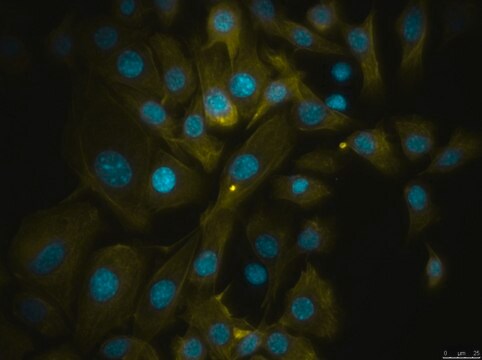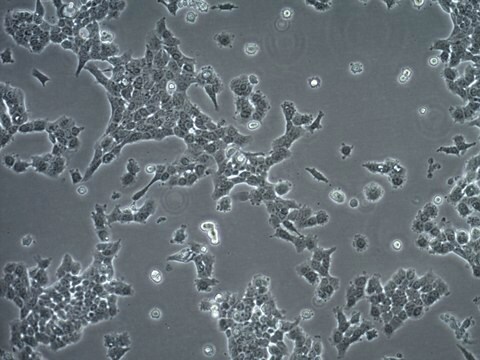推薦產品
product name
PyMT-1099 Mouse Mammary Tumor EMT Model Cell Line,
生物源
mouse
包裝
vial of ≥1X10⁶ cells/vial vials
製造商/商標名
Millipore
技術
cell based assay: suitable
cell culture | mammalian: suitable
運輸包裝
liquid nitrogen
儲存溫度
−196°C
應用
- Each vial contains > 1X106 viable cells.
- PyMT-1099 murine breast cancer cells are verified to be of mouse origin and negative for human, rat, Chinese hamster, Golden Syrian hamster, and non-human primate interspecies contamination, as assessed by a Contamination Clear panel by Charles River Animal Diagnostic Services
- Cells tested negative for infectious diseases against a Mouse Essential CLEAR panel by Charles River Animal Diagnostic Services.
- Cells tested negative for mycoplasma.
特點和優勢
PyMT-1099 cells can serve as a critical model that can replicate dynamic “plastic” changes associated with all stages of EMT and MET in cancer cells both in vitro and in vivo.
標靶描述
PyMT-1099 is a stable murine breast cancer cell line derived from a mammary tumor (mammary gland 2/3) of MMTV-PyMT (mouse mammary tumor virus-polyomavirus middle tumor-antigen) transgenic female mouse of FVB/N background (Saxena 2018). PyMT is an oncogene which transforms cells in culture and leads to formation of mammary tumor in MMTV-PyMT mouse by interacting with non-receptor tyrosine kinase, c-Src (1).These cells have a well differentiated, cobblestone-like morphology similar to epithelial cells and have PyMT transgene in their genome. Orthotopic implantation of these cells in immunocompromised NOD/SCID, common gamma receptor −/− (NSG) mice resulted in formation of palpable tumor after 14 weeks. Also, 50% of the mice had macroscopic metastatic tumors in their lungs exhibiting invasive characteristics (2).Breast cancer is currently the most common cancer globally. In the United States, around 287,850 new cases of invasive breast cancer and 43,250 breast cancer associated deaths were estimated in 2022 (3). Epithelial-mesenchymal transition (EMT) is a process involved in the initiation of the invasion-metastasis cascade of cancer cells. PyMT-1099 undergo epithelial-mesenchymal transition (EMT) in response to TGFβ addition in vitro and undergo a complete mesenchymal to epithelial transition (MET) upon TGFβ withdrawal. TGFβ treatment (2 ng/mL) of PyMT-1099 cells resulted in complete reduction of epithelial markers such as E-cadherin and Zona Occludens (ZO-1), while the mesenchymal markers Fibronectin (FN1) was significantly, and N-Cadherin was moderately upregulated as evidenced by immunofluorescence (2). Although stimulation with TGFβ was reported to induce the canonical pathway as evidenced by nuclear translocation of the Smad2/3 complex and phosphorylation of Smad3 (4), these cells are resistant to the TGFβ induced cell cycle arrest and utilizes non-canonical TGFβ signaling to induce EMT. Long term treatment with TGFβ (2 ng/mL) for 20 days results in formation of mesenchymal subline of cells (PyMT LT) with elongated morphology. PyMT LT cells exhibit higher migratory potential compared to untreated PyMT-1099 cells or NMuMG (immortalized normal murine mammary gland) cells in a modified Boyden chamber transwell migration assay. Also, in contrast to their epithelial counterpart, PyMT-1099 cells, 100% of mice (immunocompromised-NOD) implanted orthotopically with PyMT-1099 LT cells had macroscopic lung metastatic lesions (2). SourcePyMT-1099 cells were derived from mammary tumors of MMTV-PyMT transgenic female FVB/N mice (1).References1. Shanzer M, Ricardo-Lax I, Keshet R, Reuven N, Shaul Y. 2015. The polyomavirus middle T-antigen oncogene activates the Hippo pathway tumor suppressor Lats in a Src-dependent manner. Oncogene. 34(32): 4190-4198.2. Saxena M, Kalathur RKR, Neutzner M, Christofori G. 2018. PyMT-1099, a versatile murine cell model for EMT in breast cancer. Sci Rep. 8(1): 12123. 3. Giaquinto AN, Sung H, Miller KD, Kramer JL, Newman LA, Minihan A, Jemal A, Siegel RL. 2022. Breast Cancer Statistics, 2022. CA Cancer J Clin. 72(6): 524-541. 4. Waldmeier L, Meyer-Schaller N, Diepenbruck M, Christofori G. 2012. Py2T murine breast cancer cells, a versatile model of TGFβ-induced EMT in vitro and in vivo. PLoS One. 7(11): e48651.
儲存和穩定性
PyMT-1099 cells should be stored in liquid nitrogen until use. The cells can be cultured for at least 10 passages after initial thawing without significantly affecting the cell marker expression and functionality.
免責聲明
Unless otherwise stated in our catalog or other company documentation accompanying the product(s), our products are intended for research use only and are not to be used for any other purpose, which includes but is not limited to, unauthorized commercial uses, in vitro diagnostic uses, ex vivo or in vivo therapeutic uses or any type of consumption or application to humans or animals.
儲存類別代碼
10 - Combustible liquids
水污染物質分類(WGK)
WGK 3
閃點(°F)
Not applicable
閃點(°C)
Not applicable
分析證明 (COA)
輸入產品批次/批號來搜索 分析證明 (COA)。在產品’s標籤上找到批次和批號,寫有 ‘Lot’或‘Batch’.。
我們的科學家團隊在所有研究領域都有豐富的經驗,包括生命科學、材料科學、化學合成、色譜、分析等.
聯絡技術服務








